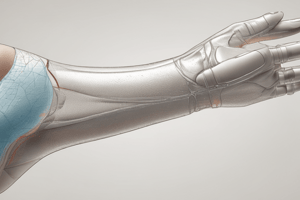Podcast
Questions and Answers
What is orthotics?
What is orthotics?
The science and art involved in treating patients by the use of an orthosis.
What is an orthosis?
What is an orthosis?
An externally applied device used to modify the structural and functional characteristics of the neuromuscular and skeletal systems.
Who is an orthotist?
Who is an orthotist?
A person who is authorized to design, measure, and fit orthoses after completing an approved education and training course.
Which of the following is NOT a purpose of an orthosis?
Which of the following is NOT a purpose of an orthosis?
Signup and view all the answers
The four categories of orthotic components are Interface, Articulating, Structural, and _______ components.
The four categories of orthotic components are Interface, Articulating, Structural, and _______ components.
Signup and view all the answers
Which component is defined as those in direct contact with the user?
Which component is defined as those in direct contact with the user?
Signup and view all the answers
The role of the physician in the orthotic team includes assessing and managing a patient’s pain control regimen.
The role of the physician in the orthotic team includes assessing and managing a patient’s pain control regimen.
Signup and view all the answers
What is one of the advantages of orthotic treatment?
What is one of the advantages of orthotic treatment?
Signup and view all the answers
What are cosmetic components in orthotics?
What are cosmetic components in orthotics?
Signup and view all the answers
Study Notes
Concentration
- Concentration is the ability to focus solely on the task at hand and avoid distractions.
Orthotics & Prosthetics
- Orthotics is the study and application of external devices to modify the structure and function of the musculoskeletal system.
- Prosthetics is the field of replacing missing limbs with artificial ones.
Orthotic Terminology
- An orthosis is an external device that improves function by stabilizing, supporting, limiting motion, controlling abnormal movements, or unloading body segments.
- An orthotist is a trained professional who designs, measures, and fits orthoses.
Advantages of Orthotic Treatment
- Pain relief
- Deformity management
- Prevention of excessive joint movement
- Increase in joint range of motion
- Compensation for limb length or shape differences
- Management of neuromuscular dysfunction
- Tissue protection
- Promotion of healing
- Providing other effects (e.g., placebo, warmth, postural feedback)
Four Categories of Orthotic Components
- Interface components: Directly contact the user and transmit forces (e.g. shells, pads, straps, foot orthoses, shoes)
- Articulating components: Allow or control motion at anatomical joints (e.g. knee, ankle, hip)
- Structural components: Connect interface and articulating components, maintain alignment (e.g. uprights)
- Cosmetic components: Provide shape, color, and texture (e.g. fillers, covers, sleeves)
Orthotic Team Roles
- Physician: Medical evaluation, diagnosis, prognosis, special considerations (skin, weight-bearing, vascular disease, spasticity), pain management, prescription, monitoring, long-term follow-up.
- Certified Orthotist: Patient evaluation, prescription generation, consulting on device design and materials, patient education, fabrication, fitting, adjustments, follow-up.
- Other Orthotic Team Members: Physical therapist, occupational therapist, rehabilitation engineer, social worker.
Studying That Suits You
Use AI to generate personalized quizzes and flashcards to suit your learning preferences.
Related Documents
Description
This quiz explores the fundamental concepts of orthotics and prosthetics, focusing on terminology, advantages of orthotic treatment, and the role of orthotists. Understand how external devices improve musculoskeletal function and manage various conditions.




